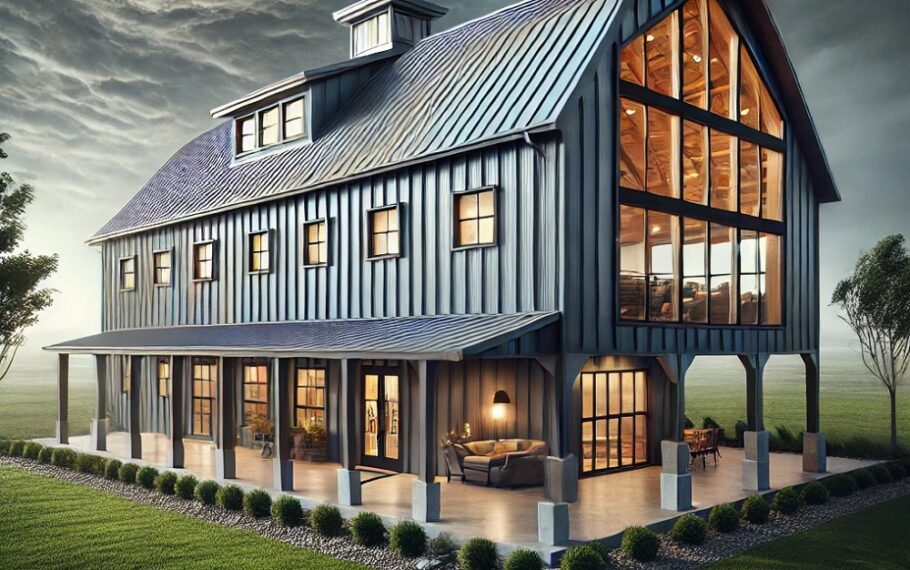When designing a barndominium, one of the most defining architectural and structural decisions involves the choice of roofing. The roof not only determines the home’s visual style—it’s also a critical component in overall performance, energy efficiency, and longevity. Two dominant options in modern metal-roofed barndominiums are architectural standing seam roofs and commercial corrugated panels. While both systems are made from durable metal sheets, their engineering differences profoundly influence installation methods, waterproofing, thermal movement control, and aesthetics.
This article explores the engineering science and practical trade-offs between standing seam and corrugated metal roofs, helping barndominium designers and owners make an informed decision that balances appearance, function, and cost.
1. The Role of Roofing in Barndominium Engineering
Barndominiums rely heavily on metal for both structural and architectural purposes. Roof systems are more than simple coverings—they integrate with framing loads, wind resistance, insulation layers, and vapor barriers. A well-engineered roof must address:
- Lateral and uplift loads from wind
- Thermal expansion and contraction in metal panels
- Water shedding and sealing under heavy rain or snow
- Integration with structural framing (trusses, purlins, or rigid frames)
- Aesthetic continuity with wall panels and architectural trim
Standing seam and corrugated panels both meet these criteria, but they do so with very different engineering strategies.
2. What is a Standing Seam Roof?
A standing seam roof is a high-performance metal roofing system characterized by vertically raised seams or ribs that interlock above the flat surface of the panels. These seams “stand” above the water plane, hence the name, and are typically mechanically seamed or snap-locked to conceal fasteners entirely.
Typical characteristics:
- Panel widths: 12–24 inches
- Seam heights: 1–2 inches
- Metal thickness: 24–26 gauge (architectural), sometimes heavier for structural systems
- Material: Galvalume steel, aluminum, or copper
- Fasteners: Hidden clips allowing movement
Standing seam systems can be structural (bearing roof loads directly) or architectural (installed over a solid deck such as plywood or steel decking).
3. What are Corrugated Panels?
Commercial corrugated metal panels, by contrast, have a repetitive wavy or ribbed profile that adds strength and rigidity. These panels are typically through-fastened, meaning screws penetrate the metal at regular intervals along the ribs, anchoring the sheet directly to purlins or decking.
Typical characteristics:
- Rib height: ⅞ inch or more
- Width: 24–36 inches
- Gauge: 26–29 for residential or light commercial, 22–24 for structural use
- Material: Galvanized or Galvalume steel
- Fasteners: Exposed with neoprene washers
While corrugated panels are more industrial and cost-effective, their exposed fasteners and lower seam height make them more vulnerable to water intrusion, thermal stress, and long-term maintenance needs.
4. Structural Engineering Comparison
Load Path and Support Spacing
- Standing seam systems can function as structural roofs, meaning the panels themselves can span between purlins without continuous decking. However, architectural variants are usually supported by solid sheathing, distributing loads more uniformly.
- Corrugated panels derive their strength from their profile geometry—the deep ribs stiffen the sheet, enabling wide spans between supports. This makes them suitable for post-frame barndominiums, where roof purlins may be spaced 24 to 48 inches apart.
Deflection and Bending
The deeper the rib or seam, the greater the panel’s moment of inertia, reducing deflection under load. Standing seam panels with taller seams resist bending better under snow load but can “oil can” (visibly ripple) due to thermal stresses. Corrugated panels, with repetitive waves, distribute bending stresses evenly but are less efficient for high-snow or long-span designs.
5. Thermal Movement and Expansion Engineering
One of the biggest engineering challenges in metal roofing is thermal expansion. A 30-foot-long metal panel can expand nearly ½ inch with a 100°F temperature swing.
- Standing seam roofs are engineered with sliding clip systems that allow panels to expand and contract freely without buckling or tearing fasteners. The seams conceal the clips, and movement occurs beneath the fold.
- Corrugated panels, being through-fastened, have no independent movement mechanism. As the metal expands and contracts, the screws take the stress. Over time, this can lead to hole elongation, seal failure, and fastener back-out—a key cause of leaks in older corrugated installations.
For this reason, standing seam roofs are preferred in climates with large temperature fluctuations or in structures with long, unbroken roof runs.
6. Waterproofing and Weatherproof Detailing
Standing Seam Systems:
- Have a hydrostatic or hydrokinetic design, depending on profile and slope.
- The raised seams prevent standing water infiltration, even in low-slope applications (as low as ¼:12).
- Seam sealants, factory-applied gaskets, and concealed clips create multiple waterproofing redundancies.
- Ideal for regions with heavy snow, wind-driven rain, or ice damming.
Corrugated Panels:
- Depend on gravity drainage, meaning the roof must be steep enough (at least 3:12 slope) to shed water efficiently.
- Each exposed screw is a potential water path, especially as neoprene washers degrade.
- Overlaps between panels (side laps and end laps) require meticulous sealant application and fastening spacing for watertightness.
From a waterproofing standpoint, standing seam systems are more robust, particularly for low-slope barndominiums or complex roof geometries.
7. Wind and Uplift Resistance
Barndominiums built in open country or coastal zones face high wind uplift pressures, which test the bond between roof panels and structure.
- Standing seam systems excel here—the concealed clip design allows for high uplift resistance ratings (tested per UL 580 or ASTM E1592).
- The interlocking seams distribute wind forces along continuous vertical lines, reducing point-load stress.
- Corrugated panels, while strong, rely on the shear capacity of fasteners. If fasteners are over- or under-torqued, uplift performance diminishes dramatically.
For hurricane-prone or tornado-prone regions, engineers often specify standing seam over corrugated due to its secure clip anchorage and reduced potential for peel failure.
8. Aesthetic and Architectural Considerations
A barndominium’s roof defines its architectural personality:
- Standing seam roofs project a sleek, modern, and refined aesthetic. They’re often used in contemporary barndominiums, mountain retreats, or farmhouse-modern designs. The clean vertical lines pair well with metal siding or board-and-batten cladding.
- Corrugated panels carry a rustic, agricultural, or industrial feel. Many homeowners embrace this look for authentic barn conversions or workshop-style barndominiums.
Additionally, standing seam roofs can integrate solar panels using clamp-on mounts that don’t penetrate the panels—an engineering advantage for sustainability-oriented builds. Corrugated roofs require penetrations and additional sealing for solar attachment.
9. Energy Efficiency and Assembly Integration
Both roofing types play roles in the thermal envelope of a barndominium.
- Standing seam systems can incorporate above-sheathing ventilation (ASV) or cool roof coatings, improving heat reflectivity and reducing attic temperatures by up to 20°F.
- Their smooth surfaces also lend themselves to radiant barriers and high-performance underlayments.
- Corrugated panels, being directly fastened to purlins, can result in more thermal bridging and uneven insulation coverage. Proper use of rigid foam or spray polyurethane insulation beneath the roof deck helps offset these limitations.
From an energy engineering perspective, standing seam systems generally provide better control of heat transfer and air sealing—especially when combined with continuous insulation.
10. Installation Complexity and Cost Engineering
The trade-off for standing seam’s performance is its complexity.
- Standing seam roofs require skilled labor, specialized seaming tools, and tighter tolerances. Panels are often factory-fabricated to length, minimizing seams but increasing logistics coordination.
- Corrugated panels, conversely, can be installed with basic tools and straightforward fastening patterns. They’re faster and cheaper to install—often 30–40% less labor cost.
From a cost-engineering standpoint:
| Factor | Standing Seam | Corrugated Panels |
| Material Cost | High | Moderate |
| Labor Cost | High | Low |
| Maintenance | Low | Moderate–High |
| Lifespan | 40–70 years | 25–40 years |
| Roof Slope Suitability | Low–steep | Moderate–steep |
| Thermal Movement Control | Excellent | Poor |
| Leak Risk | Low | Moderate–High |
11. Engineering Selection: Which Roof Fits Your Barndominium?
- Choose Standing Seam if:
- You want a long-lasting, premium roof with minimal maintenance
- Your barndominium has low-slope rooflines or complex geometry
- You live in a high-wind or snow region
- You plan to add solar panels or prioritize energy efficiency
- Architectural aesthetics matter
- Choose Corrugated Panels if:
- You’re working within a tight construction budget
- Your barndominium has a steep roof pitch
- You prefer a classic agricultural or industrial look
- Routine maintenance is acceptable in exchange for upfront savings
12. Conclusion: Engineering Beauty and Performance Together
In barndominium design, every engineering decision reflects both practicality and style. Standing seam roofs represent the pinnacle of metal roof engineering—refined, durable, and precise—while corrugated panels embody simplicity, economy, and tradition.
The key is aligning the roof system with your structural framing, climate loads, and architectural intent. When thoughtfully engineered, either system can crown your barndominium with strength, beauty, and resilience for decades to come.
Whether you favor the crisp lines of standing seams or the rugged rhythm of corrugated metal, the roof you choose will be more than just shelter—it will be the defining signature of your home’s engineering story.

